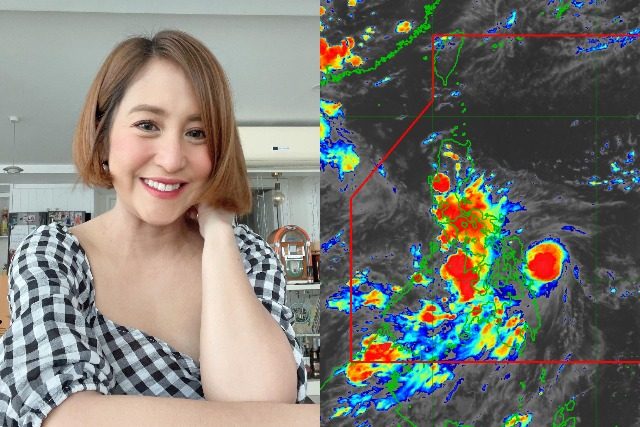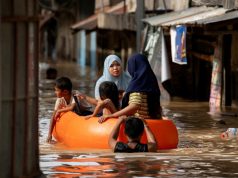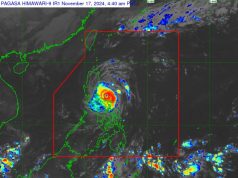
Filipinos used humor in reminding each other to keep safe amid the presence of a tropical cyclone in the Visayas and Mindanao regions with a famous namesake in the local entertainment industry.
Tropical Storm Jolina is the tenth tropical cyclone to have entered the country this year. It is also the first storm for the month of September.
The Philippine Atmospheric, Geophysical and Astronomical Services Administration said that “Jolina” is forecast to move west northwestward over the Philippine Sea east of Eastern Samar.
Based on its bulletin issued at 5 p.m., the storm’s center was estimated to be 95 kilometers east of Guiuan, Eastern Samar as of 4 p.m.
It has maximum sustained winds of 75 kilometers per hour near the center and gustiness of up to 90 kilometers per hour.
Other than Eastern Samar, “Jolina” is forecast to traverse over Albay, Camarines Norte, Quezon Province, Aurora, Ilocos Sur and the Extreme Northern Luzon.
It will make a landfall over the Northern-Central Luzon area on Thursday morning and then exit the Philippine Area of Responsibility by Friday morning.
PAGASA warned that the storm might make landfall or pass near Eastern Samar or Northern Samar based on its westward track shift.
Tropical Cyclone Wind Signal No. 1 is hoisted over the eastern portion of Camarines Sur, Catanduanes, Albay, Sorsogon, Biliran, the eastern portion of Leyte and Southern Leyte, the rest of Samar and Northern Samar, Dinagat Islands, Siargao Islands and Bucas Grandes Islands.
Meanwhile, Signal No. 2 is raised over Eastern Samar, the eastern portion of Northern Samar and the northeastern portion of Samar.
PAGASA will issue another bulletin at 8 p.m.
In view of this, the state weather bureau advised Filipinos to “take all necessary measures to protect life and property.”
“Persons living in areas identified to be highly or very highly susceptible to these hazards are advised to follow evacuation and other instructions from local officials,” it said on its bulletin.
“For heavy rainfall warnings, thunderstorm/rainfall advisories, and other severe weather information specific to your area, please monitor products issued by your local PAGASA Regional Services Division,” PAGASA added.
The hashtag “#JolinaPH” gained traction as updates on the storm surface online.
Following this, fans of television host Jolina Magdangal used the opportunity to post quips involving the 90s icon as they hoped for their fellow Filipinos’ safety.
“Mag-ingat para hindi tayo ma-fall sa biggest mistake of falling in flood, makuryente, atbp hazards na kaakibat ng bagyo. Nang ‘di ma-chuva chu chu, mga mamshies!” a Twitter user wrote.
“Huy Jolens! Kalmahan mo lang ah!” joked another online user in response to the storm’s arrival.
“Momshie @mariajolina kalmahan mo lang ha,” a different Filipino tweeted.
“Stay safe mga Momshies. #JolinaPH,” wrote another Twitter user.
“Momshie” is a term famous among “Magandang Buhay” hosts which include Jolina herself.
The showbiz personality quipped that if it were up to her, she would let “butterflies” instead of rain fall on the affected areas of the storm.
“Stay safe everyone,” she wrote on an Instagram post with a heart emoji.
Jolina is considered one of the most successful multi-media artists in the local entertainment industry due to her success in television, movies, music, fashion and commercial advertisements in the 90s.
What’s in a name?
Last February, the storm name Jolina was among those that gained online buzz anew when the country’s first tropical cyclone for 2021 entered that month.
Other assigned names that caught attention were “Odette” and “Yasmin.”
PAGASA reuses the assigned names of tropical cyclones every five years, unless the storm causes billions of damages or 300 or so fatalities.
For 2020, the names “Ambo, Quinto, Rolly and Ulysses” were decommissioned following the damages it has brought to the country.
According to the World Meteorological Organization, storms have names to distinguish them from one another.
“Tropical cyclones can last for a week or more; therefore there can be more than one cyclone at a time. Weather forecasters give each tropical cyclone a name to avoid confusion,” it said on its website.
“The practice of naming storms (tropical cyclones) began years ago in order to help in the quick identification of storms in warning messages because names are presumed to be far easier to remember than numbers and technical terms. Many agree that appending names to storms makes it easier for the media to report on tropical cyclones, heightens interest in warnings and increases community preparedness,” WMO added.
“Experience shows that the use of short, distinctive given names in written as well as spoken communications is quicker and less subject to error than the older more cumbersome latitude-longitude identification methods. These advantages are especially important in exchanging detailed storm information between hundreds of widely scattered stations, coastal bases, and ships at sea,” it further said.









